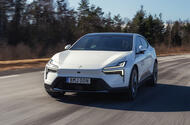
Segment-straddling Porsche Macan rival looks to inject sporting appeal into a long-range, family friendly proposition
In case you weren't keeping up, the Polestar 4 is – sensibly – the fourth model from the Swedish sporting EV brand. Somewhat less obvious is the fact that it's only slightly larger than the 2 and quite substantially smaller than the 3, but it's probably best to ignore that confounding nomenclature structure – which will soon give us a big new 5 saloon and a smaller 6 GT – and define the cars instead by their most obvious rivals.In the case of the 4, that's not especially easy. Rather like the 2, it is not immediately recognisable as an SUV, and nor does it sit quite close enough to the ground to be labelled a saloon, so it can be difficult to immediately pigeonhole. But its £60k start price and 4.8m length line it up neatly to contend with the new Porsche Macan Electric, and thus you imagine it will also be cross-shopped with the likes of the BMW iX3, Audi Q6 E-tron and Mercedes-Benz EQE SUV.Frustratingly, the same-sized Jaguar I-Pace – with its similarly segment-straddling silhouette and overt focus on dynamism – would have been one of the 4’s most obvious and natural rivals, but is getting on in years and coming up for retirement by the end of 2024, so doesn’t really bear comparison. Due to start deliveries in August, the 4 will be built initially in China, but a second production line opening soon at a Renault-owned facility in Korea could eventually supply cars to right-hand-drive markets. Polestar says it is the fastest and lowest-carbon car it has yet produced, and has lofty ambitions for the 4 to play a core role in its plan to drastically boost its global volumes, alongside the larger, US-built 3.It is Polestar’s first car atop parent company Geely’s new SEA modular platform, which means it is also the brand’s first model to not use Volvo-derived underpinnings, as do the 2 and 3. SEA is more a catch-all name for a family of architectures than a single modular structure, so the 4 is only partly related to the smaller, SEA-based Smart #1 and Volvo EX30 crossovers, which brings two crucial advantages: Polestar was able to engineer in its dynamic proclivities right from the get-go, while benefiting from the use of existing components like the electronics systems and HVAC pipework.Â

